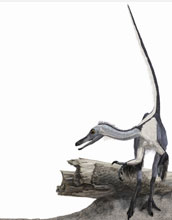All Images
News Release 10-017
Dinosaur Discovery Helps Solve Piece of Evolutionary Puzzle
Scientists' find describes how one family of dinosaurs came to look like birds--independent of birds
This material is available primarily for archival purposes. Telephone numbers or other contact information may be out of date; please see current contact information at media contacts.

See the alvarezsaur excavation in this audio slideshow.
Credit: Lisa Raffensperger, National Science Foundation

It is interesting to compare the dentition and arms of these three dinosaurs. Allosaurus, or a T. rex-like dinosaur, had sharp pointy teeth. The Alvarezsaur, Haplocheirus, had many shorter teeth, and the most bird-like dinosaur of the group, Shuvuuia, had reduced peg-like dentition. Also note the three claws of roughly equal size of the Allosaurus, the thick short thumb and two skinny fingers of Haplocheirus, and the completely reduced single digit of Shuvuuia.
Credit: Zina Deretsky, National Science Foundation
Download the high-resolution JPG version of the image. (714 KB)
Use your mouse to right-click (Mac users may need to Ctrl-click) the link above and choose the option that will save the file or target to your computer.

Reconstruction of the dinosaur Haplocheirus sollers, whose name means simple, skillful hand.
Credit: Portia Sloan
Download the high-resolution JPG version of the image. (213 KB)
Use your mouse to right-click (Mac users may need to Ctrl-click) the link above and choose the option that will save the file or target to your computer.

The skeleton of Haplocheirus sollers, a new alvarezsauroid dinosaur discovered in China, is shown.
Credit: X. Xu, J. Choiniere
Download the high-resolution JPG version of the image. (337 KB)
Use your mouse to right-click (Mac users may need to Ctrl-click) the link above and choose the option that will save the file or target to your computer.

Individual bones of Haplocheirus sollers: shoulder girdle (a,b), arm (c-f), hand (g).
Credit: J. Choiniere
Download the high-resolution JPG version of the image. (131 KB)
Use your mouse to right-click (Mac users may need to Ctrl-click) the link above and choose the option that will save the file or target to your computer.

Paleontologists uncover a Haplocheirus sollers skeleton in China.
Credit: J. Clark
Download the high-resolution JPG version of the image. (984 KB)
Use your mouse to right-click (Mac users may need to Ctrl-click) the link above and choose the option that will save the file or target to your computer.

Jonah Choiniere excavates a sediment block in a sandstorm in China.
Credit: J. Clark
Download the high-resolution JPG version of the image. (1.7 MB)
Use your mouse to right-click (Mac users may need to Ctrl-click) the link above and choose the option that will save the file or target to your computer.

Excavating dinosaur skeletons is slow, painstaking work for paleontologists.
Credit: J. Clark
Download the high-resolution JPG version of the image. (1.3 MB)
Use your mouse to right-click (Mac users may need to Ctrl-click) the link above and choose the option that will save the file or target to your computer.

The researchers' findings appear in the Jan. 29 issue of the journal Science.
Credit: Copyright AAAS 2010
Download the high-resolution JPG version of the image. (1.5 MB)
Use your mouse to right-click (Mac users may need to Ctrl-click) the link above and choose the option that will save the file or target to your computer.
